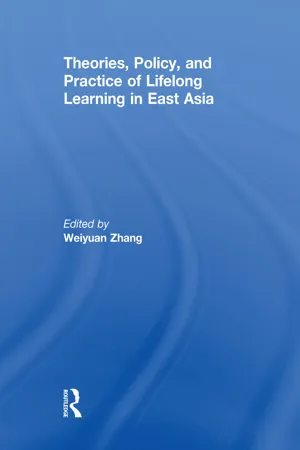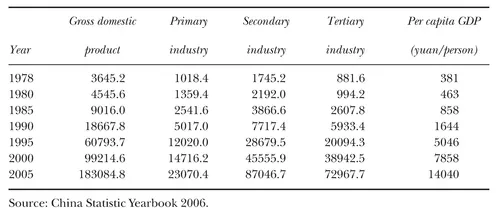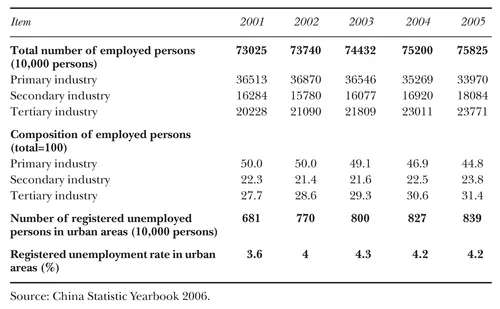![]()
Policies and practices of lifelong learning in China
JIAN HUANG and WEIPING SHI
East China Normal University, Shanghai, China
This paper focuses on the development of policies and practices related to lifelong learning in the last 10 years in China. It gives a brief introduction of the vital societal changes and offers a review on outstanding achievements in school education, which can be regarded as the context and infrastructure of lifelong learning enterprise. It analyses in depth the relevant national strategies adopted by the central government, which have been the fundamental guidelines for the practice of lifelong learning. After exploring the flourishing lifelong learning activities promoted by the government, industry and other nongovernmental agencies, it finally discusses the state-led promoting model of lifelong learning in China.
The changing context of lifelong learning in the new century
The idea of lifelong education in the 1960s was introduced into China after the cultural revolution (Zhong 1979). However, it did not have an initial influence on educational policies until the early 1990s. The National Education Innovation and Development Outline (Ministry of Education 1993) first embraced the concept of lifelong education. The 11th item of National Education Law of China (Ministry of Education 1995) further claimed that ‘the state will progressively establish and perfect the lifelong education system’. But it was not until the last 10 years that the idea of lifelong education found its way into Chinese society, and it has accompanied enormous social changes in China.
Since the open-door policy was adopted in 1978, great societal changes have come about. The most obvious one is the fast growth of the economy in the last 28 years (table 1). The per capita GDP increased from CNY 381 (about $49.5) in 1978 to CNY 14040 (about $1823) in 2005. Relevantly, there had been great changes in the structures of industries, occupations and employment, which resulted in unemployment problems in rural and urban China (table 1 and table 2).
There are more than 150 million extra rural workers moving to urban areas, floating to the secondary or tertiary industry with low skills and payments. In addition,
Table 1. Gross Domestic Product (100 million yuan)
with the pervasion of the information and knowledge economy, more cross-skilled knowledge workers are needed. However, the qualified status of the whole workforce is not optimistic. Among 70 million technical workers, there were only 3.5% high-skilled workers and 1.5% high-skilled technicians. The average number of years of education received by the Chinese workforce is 7.97, which was about 4.5 years lower than the average level in developed countries (Ding et al. 2006). Moreover, gaps in income, education level and living situation between the rural and the urban, the poor and the rich are more and more surprising, threatening societal harmony and security. All these rapid changes in the phase of societal transition have led to the emergence of varied learning needs. The Chinese have realised that lifelong learning is a crucial tool for individuals adapting in the current society and for the state reviving in the globalised world.
Table 2. Employment
According to the NELC, the whole education system in China is divided into four parts, although this has always been criticised on its vague intentions. They are general education (including elementary and secondary education), higher education, vocational education and adult education. Broadly speaking, all parts are under the whole umbrella of lifelong learning policies. Although this paper mainly focuses on the policies relevant to those outside the school system, it makes sense to have a brief review of the achievements of school education which are generally regarded as an important infrastructure for lifelong learning.
Since 1995 the central government (Jiang 1995) has promoted an important national strategy, namely invigorating the country through science and education. With its strong influence, two national education conferences were held and several significant documents such as NEIDO were issued, which consequently brought about great achievements in school education. It has provided more and more opportunities for the citizens to cultivate their lifelong learning abilities and attitudes.
Up to the end of 2000, China had successfully realised its ‘two basic’ educational objectives set in 1992, diffusing nine-year compulsory education and eliminating illiteracy among the young and middle-aged. In 2005, the enrolment rate for children of elementary school age had reached 99.15%, and the gross enrolment rate for junior high school was 95%. The total number of children who receive nine-year compulsory education is about 170 million (according to Ministry of Education website 2005).
Since 1999, the central government has called for more development of higher education. According to the Report of Education Statistics of 1998 and 2005 (Ministry of Education [MOE] 1998, 2005), the total number of students in higher education institutions in China was 6.43 million and the gross enrolment rate of higher education was 9.7%. In 2005 these two numbers reached 23 million and 21%, respectively (figure 1).
Simultaneously, the two national vocational education conferences were held and the key decisions were issued in 2002 and 2005 (State Council 2002, 2005). After that with the aim of cultivating a highly competitive workforce, noticeable progress has been made in vocational education. The number of enrolments in vocational secondary education has increased by one million annually and will reach eight million in 2010, which will equal the number of enrolments in general secondary education, whereas the number of enrolments in higher vocational education has made up more than 50% of those in higher education, thus making a great contribution to its popularity in China (Ministry of Education website; Huang 2003a).
Figure 1. Number of new enrolment students in general higher education institutions 1998–2005
The central government’s ‘two strategies’ and ‘two systems’ for building a learning society
In 1987, the State Council issued the Decision on Intensifying Development of Adult Education, which had a profound influence on adult education practice (Ministry of Education 1987). But since that there has been neither any national adult education conference nor forceful documentation. It seems that the development of adult education today is not encouraged. However, if we simply conclude that adult education has largely gone into a decline, it is like the story of the blind men and the elephant. In fact, the central government has realised that it is impossible to improve the vocational and life skills of millions of adults, promote the growth of the economy and construct a harmonious society only by developing school education. Instead, it has repeatedly stressed the significance of lifelong learning for all. At the National Education Conference of 1999, the former president Jiang pointed out:
Lifelong learning is the trend of the world…. We should gradually set up and perfect the educational system that is helpful to lifelong learning. General education, vocational education, adult education and higher education should strengthen their articulation and integration, providing various education services for learners. (Jiang 1999a)
At the APEC Human Resource Development forum, Jiang (2001) put forward his ‘five propositions of human resource development’. One of these was to ‘construct a lifelong education system, create a learning society’. In the report of the 16th National Congress of Communist Party of China (National Congress of Communist Party of China [NCCPC] 2002), the aim ‘to form a lifelong learning and learning for all society, promote people’s overall development’ was written into the Communist Party’s official document. All of these have greatly inspired people’s learning enthusiasm.
In October 2003, the report of the Third Plenary of the 16th NCCPC claimed that, ‘We should deepen education system reform. We should construct a modern national education system and a lifelong education system’. Here the former referred to the school education system and the latter mainly referred to informal education and learning activities that happened outside school. Although ‘the two systems’ resulted in debates on their vague and overlapping meaning, they made the goal of building a learning society more concrete (NCCPC 2002).
In order to form the ‘lifelong education system’, the Central Council of Communist Party of China (CCCPC) and the State Council held the first National Talents Conference in December 2003. Here ‘talents’ implied those who were able to be creative and innovative, making contributions to economic, social and cultural development in society. It deconstructed the traditional concept of talents that stressed academic credentials. At the conference the central government advocated the strategy of ‘invigorating China through talents’, aiming at ‘transforming the huge population pressure into abundant human resource’ (Central Council of Communist Party of China and State Council 2003). By ‘invigorating China through science and education’, it has become the fundamental guideline of constructing a learning society in China.
Lifelong learning as a nationwide broad action
With the strong political influences from CCCPC and the State Council, some ministries of central government have been working as chief departments for promoting nationwide lifelong learning activities. Besides the industry sector, local government, the academic community and NGOs have also become positive forces for promoting lifelong learning in China. They constitute a colourful picture of constructing a learning society in China in the new century.
Rural adult education
In recent years, the education of 900 million farmers has attracted great attention from the central government. According to the Decision on Further Strengthening Rural Education (State Council 2003), ‘rural education plays a significant role in the construction of the modern national education system and a learning society’ and ‘farmers’ training should be the focus of the rural adult education’, which had two main kinds of urgent tasks: life and vocational skill training for extra rural labourers and agricultural skill training for farmers. In early 2007, the CCCPC and the State Council issued a document, Fostering Modern Farmers for Constructing the New Socialism Rural Areas which further highlighted the significance of rural education (CCCPC and State Council 2007).
The Ministry of Agriculture (MOA) has played a leading role in farmers’ training. It issued the National Training Plan for Rural Workers 2003–2010 and initiated the National Sunshine Training Project. In the first three years, the Sunshine Project provided training for 10 million persons annually. In the next five years it will increase the number up to 50 million per year. The financial support for the Sunshine Project reached 125 million Yuan from the central government and over 150 million Yuan from local provincial governments (Wei 2006). Another national project named S...



